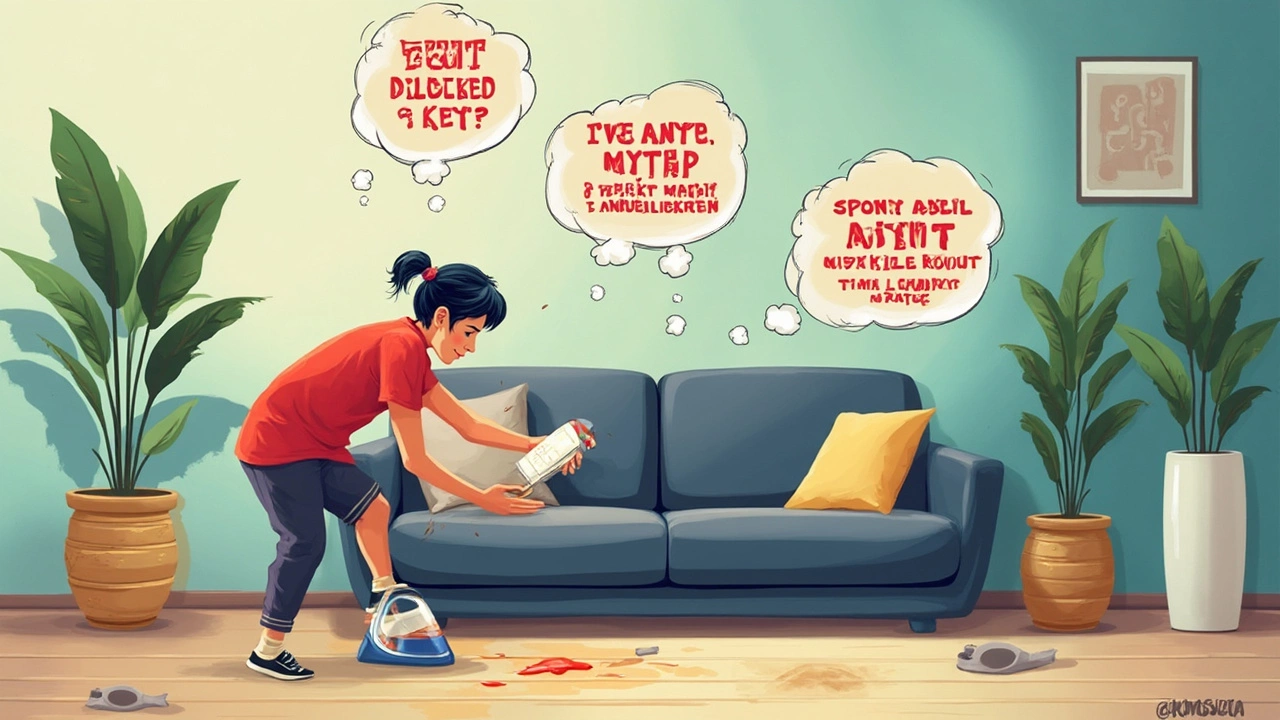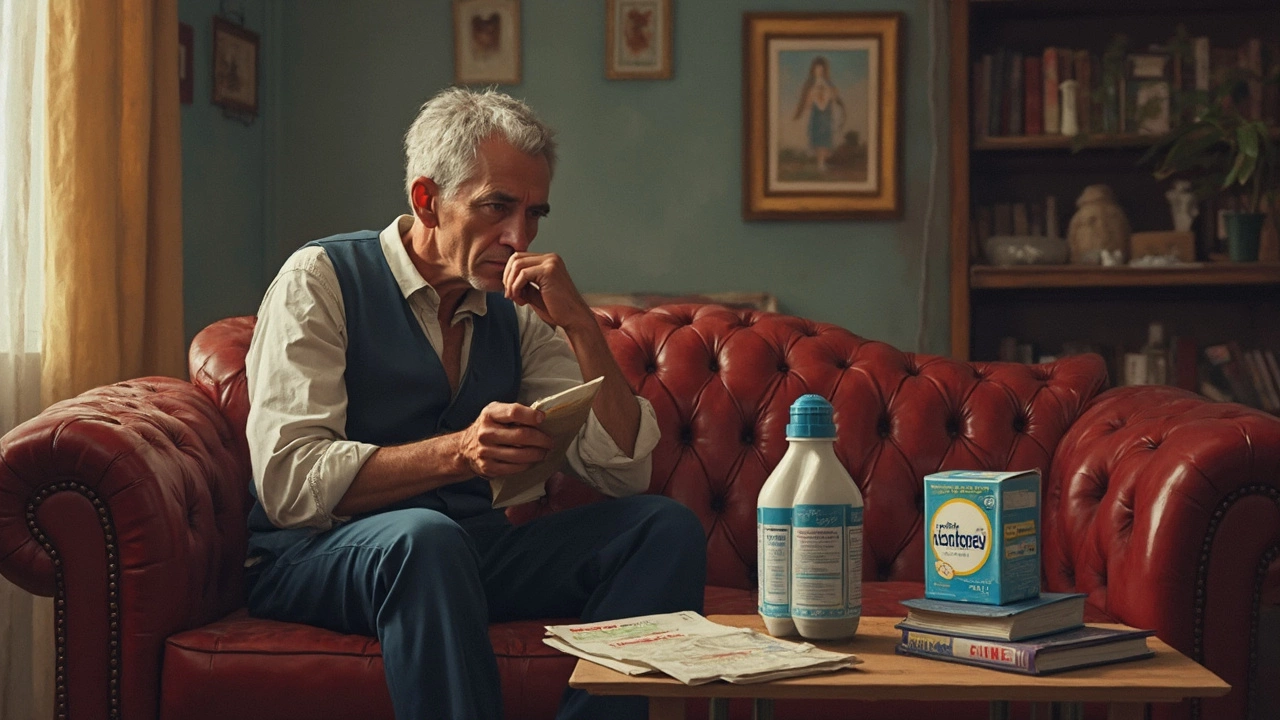Stuck with a spill on your sofa and eyeing that bottle of laundry detergent? It’s tempting—after all, it tackles tough stains on your clothes every week. But upholstery isn’t just ‘big clothing.’ The fibers, dyes, and construction are totally different from your average T-shirt.
If you use laundry detergent on upholstery, it can pull out some stains, especially on synthetic or sturdy fabrics. But things get tricky fast. Certain detergents can leave behind sticky residue, attract even more dirt, or fade the colors on delicate materials. If your couch has tags like “S” or “WS,” you need to pay attention—some detergents can wreck your sofa’s texture or shrink the fabric.
Not all is lost, though. In a pinch, a tiny drop of mild, fragrance-free liquid detergent mixed with cool water can spot-clean a fresh stain. Blot—don’t rub!—and always test on a hidden area first. You’d be surprised how much gunk comes up if you use a clean, white towel and gentle pressure.
- What Makes Upholstery Different?
- How Laundry Detergent Works on Fabric
- When Can You Use Laundry Detergent on Upholstery?
- Risks and Common Mistakes
- Better Ways to Clean Upholstery
What Makes Upholstery Different?
Ever wonder why cleaning your couch just isn't as simple as tossing it in the wash with a scoop of detergent? Upholstery isn’t made to handle rough treatment. Most sofas are built from layered materials that each react differently to cleaners, water, and scrubbing. You’ve got your surface fabric—anything from cotton to microfiber—plus padding, liners, stitching, and sometimes even glue. These layers are what make your furniture comfy but tricky to clean.
Here’s the kicker: a cleaning method that’s fine for one fabric can totally destroy another. For example, a polyester chair might shrug off a quick blot with diluted soap, but a silk-covered cushion? That’s a disaster waiting to happen.
| Common Upholstery Fabric | Typical Cleaning Code | Main Cleaning Risks |
|---|---|---|
| Cotton | W, WS | Shrinking, fading |
| Polyester | W, WS | Pilling, residue build-up |
| Microfiber | S, W, WS | Water spots, flattening |
| Wool | S | Shrinkage, felting |
| Silk | S | Color bleed, damage |
Those cleaning codes matter—W means water-based cleaner, S is for solvent only, and WS gives you options. If you ignore the code, you could end up with ugly stains or, worse, a couch that feels weird or loses shape. That’s why using laundry detergent isn’t always a slam dunk. Over-wetting, wrong pH, or too much suds can seep into the layers and mess up more than just the surface.
Tip: Always check the manufacturer’s label or tag. If it’s missing, test any product on a hidden patch first. If you see color on your towel or fabric puckering, stop right there—it’s not safe.
How Laundry Detergent Works on Fabric
Laundry detergent isn’t magic, but the way it tackles dirt and stains is actually pretty cool. Detergents use special chemicals called surfactants. These surfactants grab on to grime, grease, and oil, which are usually tough to rinse away with water alone. Once the surfactant attaches, it basically makes dirt float off the fabric so you can blot or rinse it out.
This is why laundry detergent is a winner on clothes—it’s made to pull away sweat, food, and mud without beating up your favorite shirt. But upholstery fabrics don’t always play by the same rules. Sofas and chairs might have tighter weaves, delicate threads, or dyes that bleed faster than what you’d see in jeans or towels. So while the laundry detergent does its thing, the fabric itself reacts differently.
To give you an idea of just how effective detergent can be, check out this quick comparison:
| Stain Type | Detergent Removal Rate (on clothing) |
|---|---|
| Grease | Up to 90% |
| Coffee/Tea | 70%-85% |
| Wine | 60%-75% |
On upholstery, though, those numbers drop fast—sometimes by half—if the fabric is delicate or the stain has set.
"Surfactants in laundry detergents are designed for fibers that are rinsed thoroughly," says Dr. Heather Taylor, a textile scientist.
"When these products stay in furniture fabric, they can attract more grime or make fibers sticky over time."
Bottom line: detergent works great on fibers meant for it, but upholstery fabrics don't always respond the same way. That’s why using detergent on your couch or chair should be a careful, case-by-case move—never a default.

When Can You Use Laundry Detergent on Upholstery?
So, when does it actually make sense to reach for laundry detergent? The answer depends a lot on your upholstery’s cleaning code, which is found on the tag—usually under the cushions. Codes like “W” (water-based cleaner) mean you’re good to go with water-based stuff, while “WS” is more forgiving. Skip detergent if you see just an “S” (solvents only) or an “X” (vacuum only).
If your couch says “W” or “WS,” you can try using a little detergent—just make sure it’s a gentle liquid kind, not a powder and definitely not with bleach or fabric softener mixed in. You shouldn’t pour it straight on the fabric, though. Instead, mix one teaspoon of detergent in about four cups of cold water. Less is definitely more.
- Check the tag for "W" or "WS" codes.
- Test your mix on a hidden spot first; wait 10 minutes to make sure it doesn’t fade or damage.
- Blot, don’t scrub. Heavy rubbing can mess up the fibers and leave a ring.
- Once you’ve wiped up the spot, go back with a clean damp towel to rinse off the detergent. This step helps dodge sticky residue.
- Let things air-dry fully—open a window or aim a fan if you’re impatient.
Here’s a quick reference for different fabric codes and what they allow:
| Fabric Code | You Can Use Laundry Detergent? | Other Safe Cleaners |
|---|---|---|
| W | Yes | Water-based cleaners, mild detergent |
| WS | Yes (cautiously) | Water-based or solvent cleaners |
| S | No | Solvent-based cleaners only |
| X | No | Vacuum only |
Most retail upholstery runs on “W” or “WS” codes, but always double-check. As quoted by furniture care expert Jill Koch,
"If you’re using laundry detergent, less is more. Go gentle—your upholstery’s not a pair of dirty jeans."
One more tip: skip this hack on leather, suede, or anything vintage and delicate. Those guys need their own cleaners and a lighter touch.
If you want to play it really safe, there are plenty of upholstery cleaners out there made just for the job. But if you’re game to do it yourself, just follow the steps above, start small, and keep an eye out for any weird results.
Risks and Common Mistakes
Here’s where things can go sideways fast. Using laundry detergent as an upholstery cleaning method isn’t always safe, even if you see a dirty patch screaming for help. That stuff’s made for t-shirts, not your living room centerpiece. You could end up making a mess much bigger than the one you started with.
First, detergents can leave residue. If you don’t rinse all of it out, your couch fibers might get stiff or sticky. Worse, they act like a magnet for new dirt and stains. You’ll probably notice things looking tired and grubby way quicker than before. According to the Institute of Inspection Cleaning and Restoration Certification,
“Using too much detergent or not thoroughly rinsing can permanently attract soils to upholstered fiber, shortening the lifespan of your furniture.”
Second problem: fading and bleaching. Some laundry detergents, especially ones with optical brighteners or bleach, can drain color from your upholstery. That’s extra risky if your sofa fabric didn’t come straight from the bargain bin.
Over-wetting is a classic mistake. You might think the more liquid, the better. Wrong. Soaking the fabric and cushioning means trapped moisture and a perfect breeding ground for mildew or that musty smell nobody wants. It’s even easier to do this when you’re using a sudsy product like laundry detergent.
And here’s a head-scratcher: scrubbing too hard. You spot a bad stain and go at it like you’re cleaning a frying pan. Big mistake. Aggressive rubbing can damage the weave and finish, making one tiny issue a permanent eyesore.
- Always avoid using hot water, which can set stains and shrink or warp some fabrics.
- Never skip the spot-test on a hidden part of your upholstery, since some materials react badly, especially natural fibers like wool or silk blends.
- Don’t use colored detergents—they can leave their own stains behind.
It’s easy to reach for what you have on hand, but remember: cushions aren’t clothes. Take it slow and use laundry detergent for what it’s made for, unless you really know what you’re doing and are fully ready to gamble with your furniture.

Better Ways to Clean Upholstery
If you really want to avoid frustration (and permanent stains), the first step is to check the cleaning code on your furniture tag. Most labels will say things like “W,” “S,” “WS,” or “X.” Here’s why it matters: “W” means water-based cleaners are safe, “S” means only solvent-based stuff is allowed, “WS” means you can use both, and “X” means call the professionals or just vacuum—it can’t handle liquid cleaners at all.
For everyday messes and dirt, vacuuming is your best friend. Use a brush attachment to grab dust and crumbs in all those cracks. For average sofas (especially those labeled “W” or “WS”), you can mix up a simple at-home cleaner:
- Grab a spray bottle. Fill it with two cups of warm water, a tablespoon of white vinegar, and a teaspoon of dish soap.
- Spray a bit on a hidden area to make sure it doesn’t mess up the color.
- If it’s fine, apply the solution to stained spots using a clean microfiber cloth. Gently blot—don’t rub.
- Rinse the spot with a new cloth and plain water, then blot dry with towels.
You can also find special upholstery cleaners at hardware stores. These products are designed for your couch fibers, so there’s less risk of weird smells or sticky patches. If you’ve got pet hair or sand stuck deep in the fabric, a lint roller and a stiff brush help way more than any spray.
If you’re worried about big-time stains (like red wine or ink), don’t panic. For tough cases, there are spray foam upholstery cleaners that work on set-in gunk. Just follow the directions and keep the windows open while it dries. And if nothing works, don’t forget—professional upholstery cleaning gets deeper results and keeps your upholstery cleaning drama to a minimum.
